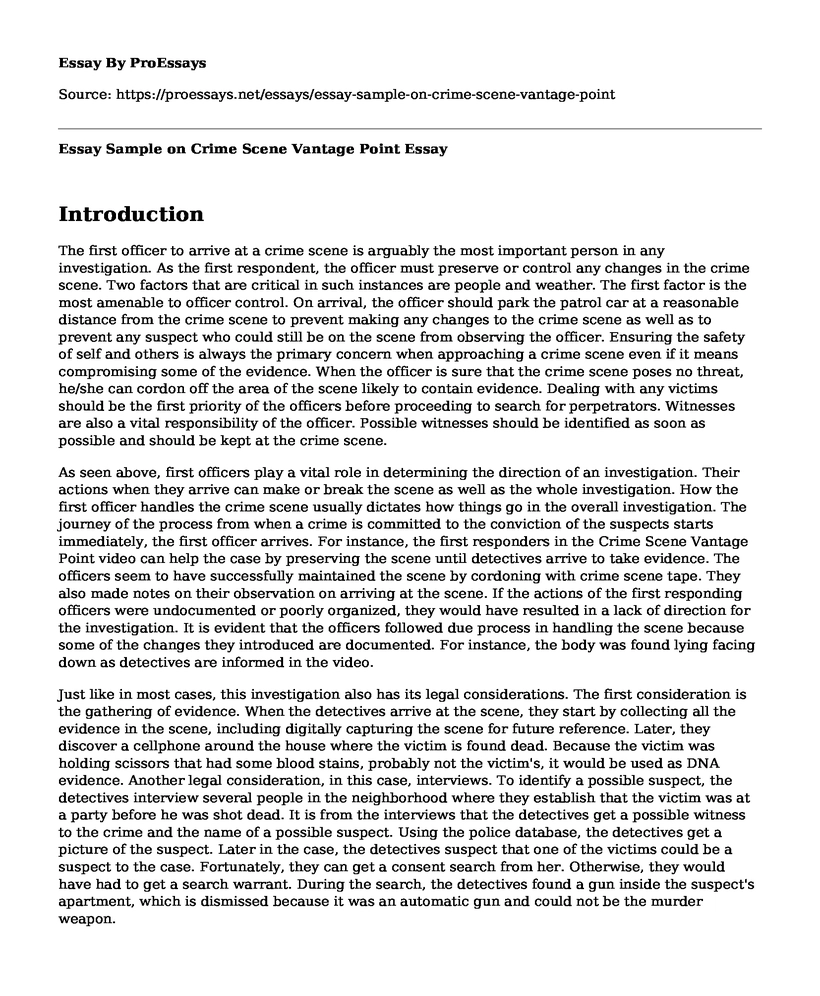Introduction
The first officer to arrive at a crime scene is arguably the most important person in any investigation. As the first respondent, the officer must preserve or control any changes in the crime scene. Two factors that are critical in such instances are people and weather. The first factor is the most amenable to officer control. On arrival, the officer should park the patrol car at a reasonable distance from the crime scene to prevent making any changes to the crime scene as well as to prevent any suspect who could still be on the scene from observing the officer. Ensuring the safety of self and others is always the primary concern when approaching a crime scene even if it means compromising some of the evidence. When the officer is sure that the crime scene poses no threat, he/she can cordon off the area of the scene likely to contain evidence. Dealing with any victims should be the first priority of the officers before proceeding to search for perpetrators. Witnesses are also a vital responsibility of the officer. Possible witnesses should be identified as soon as possible and should be kept at the crime scene.
As seen above, first officers play a vital role in determining the direction of an investigation. Their actions when they arrive can make or break the scene as well as the whole investigation. How the first officer handles the crime scene usually dictates how things go in the overall investigation. The journey of the process from when a crime is committed to the conviction of the suspects starts immediately, the first officer arrives. For instance, the first responders in the Crime Scene Vantage Point video can help the case by preserving the scene until detectives arrive to take evidence. The officers seem to have successfully maintained the scene by cordoning with crime scene tape. They also made notes on their observation on arriving at the scene. If the actions of the first responding officers were undocumented or poorly organized, they would have resulted in a lack of direction for the investigation. It is evident that the officers followed due process in handling the scene because some of the changes they introduced are documented. For instance, the body was found lying facing down as detectives are informed in the video.
Just like in most cases, this investigation also has its legal considerations. The first consideration is the gathering of evidence. When the detectives arrive at the scene, they start by collecting all the evidence in the scene, including digitally capturing the scene for future reference. Later, they discover a cellphone around the house where the victim is found dead. Because the victim was holding scissors that had some blood stains, probably not the victim's, it would be used as DNA evidence. Another legal consideration, in this case, interviews. To identify a possible suspect, the detectives interview several people in the neighborhood where they establish that the victim was at a party before he was shot dead. It is from the interviews that the detectives get a possible witness to the crime and the name of a possible suspect. Using the police database, the detectives get a picture of the suspect. Later in the case, the detectives suspect that one of the victims could be a suspect to the case. Fortunately, they can get a consent search from her. Otherwise, they would have had to get a search warrant. During the search, the detectives found a gun inside the suspect's apartment, which is dismissed because it was an automatic gun and could not be the murder weapon.
Conclusion
The police were able to collect DNA evidence from the scissors as well as the victim's body. Most of the evidence was collected in the crime scene to avoid the likelihood of contamination or changes to the evidence during transportation to the medical examiner. The medical examiner also does an autopsy of the victim's body. The bullet that was used to kill the victim was also found in a nearby window and would be used to identify the gun and possibly the owner of the murder weapon. A cellphone was found on the ground around the house close to the victim. Agreeably, both the police officers and detectives did a positive work in this case because within the first 12 hours, they already had several witnesses and a possible suspect. The detectives follow every lead that they got regarding the case. When they realize the first witness was missing, they get police officers to find her so that they can get more details. The witness gives the detail that leads to the arrest of the suspect who claims he killed the victim in self-defense. While the victim had stabbed the suspect several times before he was shot, the self-defense claim would not be successful because the victim was already on the ground when the suspect shot him in the head.
Cite this page
Essay Sample on Crime Scene Vantage Point. (2023, Jan 16). Retrieved from https://proessays.net/essays/essay-sample-on-crime-scene-vantage-point
If you are the original author of this essay and no longer wish to have it published on the ProEssays website, please click below to request its removal:
- Closing Submission for the Prosecution Paper Example
- Essay Sample on Act 21 Law: Juvenile Custody Reforms & Mental Disability Challenges
- Essay Example on Powell v. CA: 8th Amendment & Supreme Court Ruling
- Marijuana Legalization: The Public Controversies & National Effects - Research Paper
- Essay Example on The Last Gangster: Exploring the Downfall of Ill Lives Population
- Death Penalty: A Necessary Deterrent for Serious Offenses? - Essay Sample
- Ex-Convicts Reentering Society: Challenges & Solutions - Essay Sample







